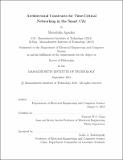Architectural constructs for time-critical networking in the smart city
Author(s)
Agaskar, Manishika P
DownloadFull printable version (6.083Mb)
Other Contributors
Massachusetts Institute of Technology. Department of Electrical Engineering and Computer Science.
Advisor
Vincent W.S. Chan.
Terms of use
Metadata
Show full item recordAbstract
The rapid maturation of the Internet of Things and the advent of the Smart City present an opportunity to revolutionize emergency services as both reactive and preventative. A well-designed Smart City will synthesize data from multiple heterogeneous sensors, relay information to and between emergency responders, and potentially predict and even preempt crises autonomously. In this thesis, we identify distinctive characteristics and networking requirements of the Smart City and then identify and evaluate the architectural constructs necessary to enable time-critical Smart City operations. Two major goals inform our architectural analysis throughout this work. First, critical traffic must be served within a specified delay without excessive throttling of non-critical traffic. Second, surges in critical traffic from a geographically-concentrated region must be handled gracefully. To achieve these goals, we motivate, evaluate, and finally recommend: 1.) connecting local area Smart City networks to the existing metropolitan area networking infrastructure, 2.) standing up a dedicated municipal data center inside the metropolitan area served by the Smart City, 3.) deploying a contention-based priority reservation MAC protocol that guarantees latency and throughput for some specified maximum number of critical users per wireless access point, 4.) configuring MAN routers to provide non-preemptive priority service at output queues to critical Smart City traffic, 5.) offering dedicated optical paths from edge routers to the municipal hub in order to effectively form a virtual star topology atop a MAN mesh and significantly reduce switching delays in the network, 6.) processing select applications at dedicated fog servers adjacent to edge routers in order to reduce upstream congestion in the MAN, and 7.) setting up a network orchestration engine that monitors traffic into and out of the Smart City data center in order to preemptively detect critical traffic surges and to direct network reconfiguration (access point reassignment, load-balancing, and/or temporary resource augmentation) in anticipation.
Description
Thesis: Ph. D., Massachusetts Institute of Technology, Department of Electrical Engineering and Computer Science, 2018. This electronic version was submitted by the student author. The certified thesis is available in the Institute Archives and Special Collections. Cataloged from student-submitted PDF version of thesis. Includes bibliographical references (pages 203-211).
Date issued
2018Department
Massachusetts Institute of Technology. Department of Electrical Engineering and Computer SciencePublisher
Massachusetts Institute of Technology
Keywords
Electrical Engineering and Computer Science.